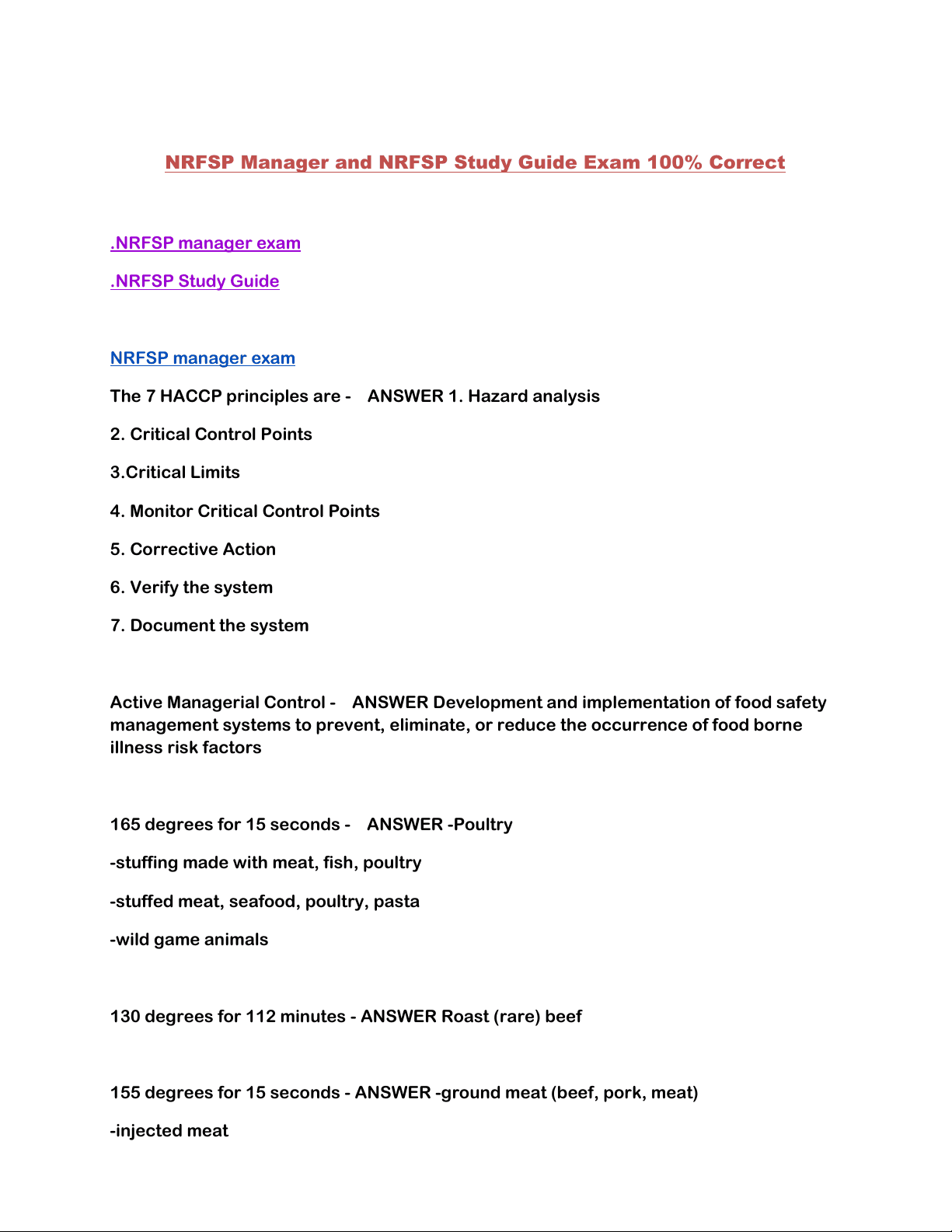
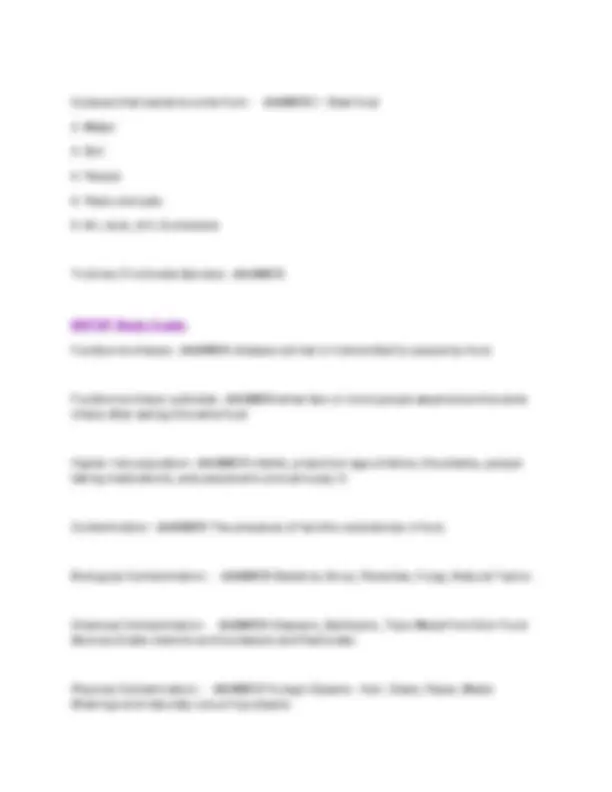
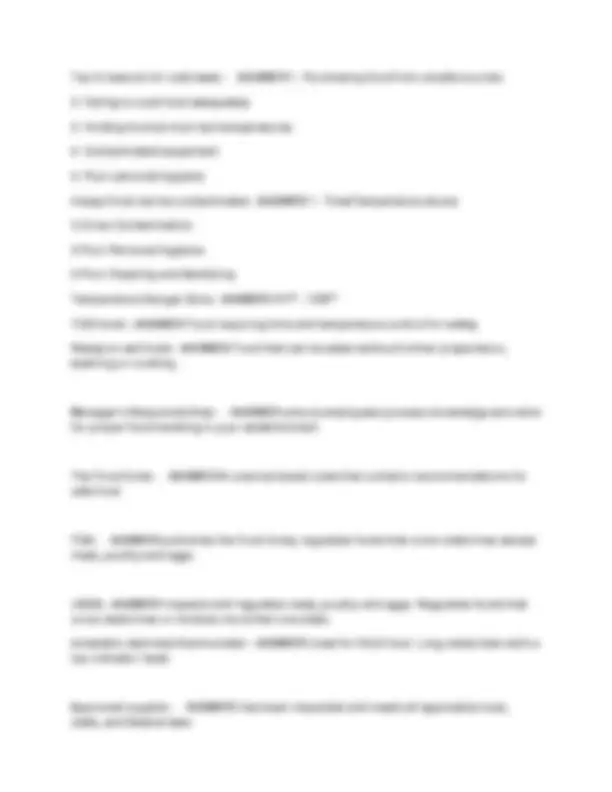
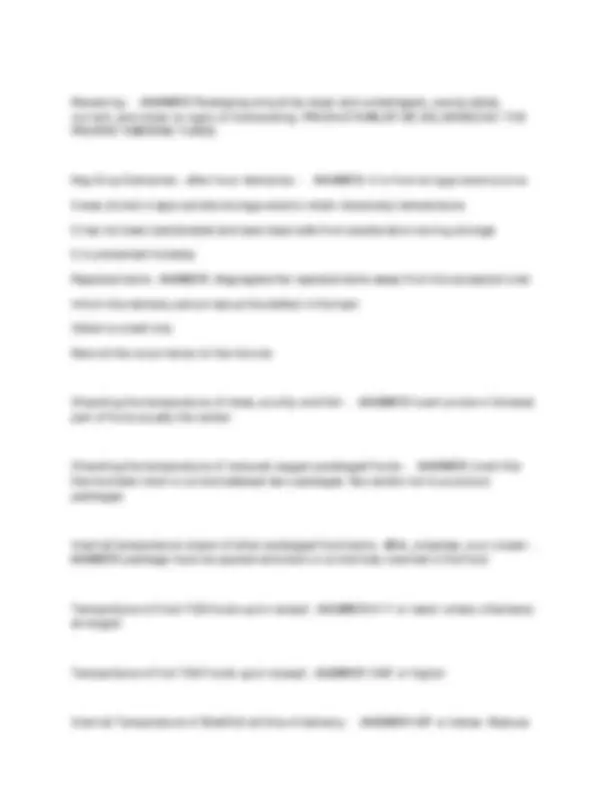
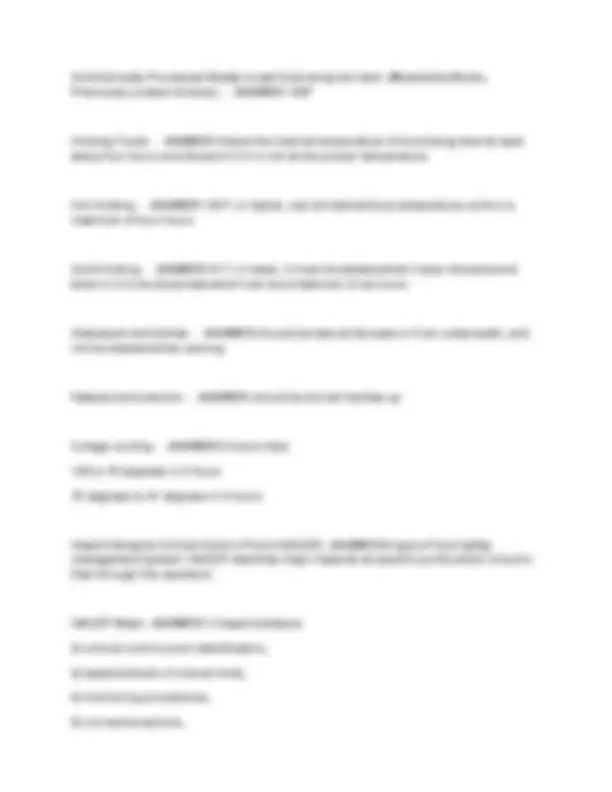
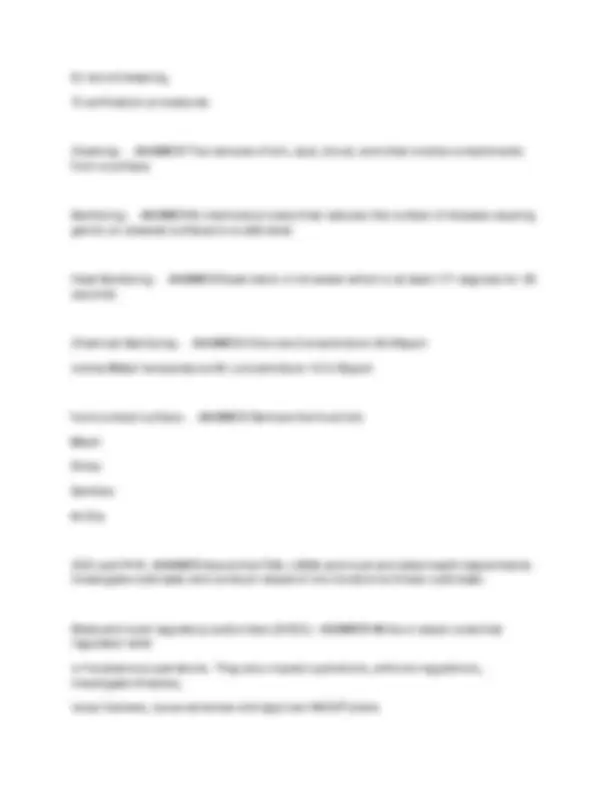
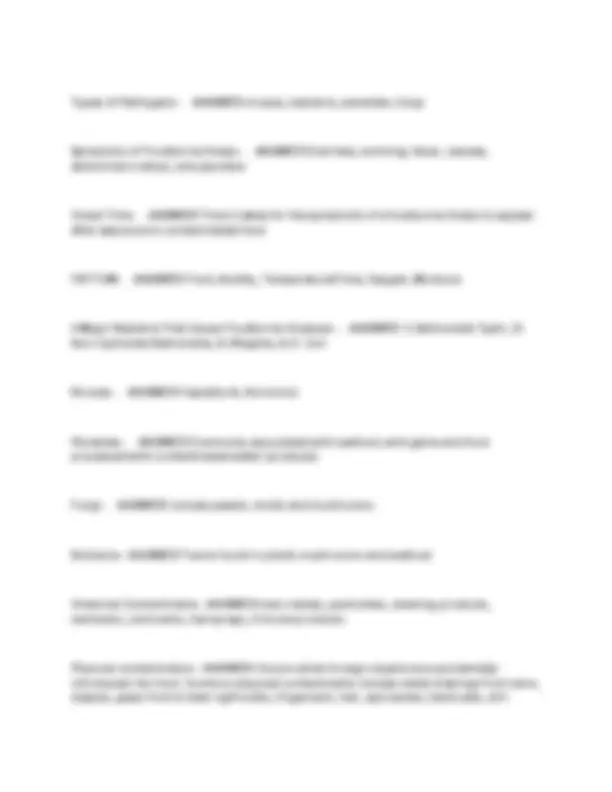


Study with the several resources on Docsity

Earn points by helping other students or get them with a premium plan


Prepare for your exams
Study with the several resources on Docsity

Earn points to download
Earn points by helping other students or get them with a premium plan
Community
Ask the community for help and clear up your study doubts
Discover the best universities in your country according to Docsity users
Free resources
Download our free guides on studying techniques, anxiety management strategies, and thesis advice from Docsity tutors
A comprehensive overview of food safety principles and practices, focusing on the nrfsp (national restaurant food safety program) manager exam. It covers key topics such as haccp (hazard analysis critical control point), foodborne illness, temperature control, cleaning and sanitizing, and food handling procedures. Questions and answers, making it a valuable resource for individuals preparing for the nrfsp manager exam.
Typology: Exams
1 / 12

This page cannot be seen from the preview
Don't miss anything!







.NRFSP manager exam .NRFSP Study Guide NRFSP manager exam The 7 HACCP principles are -2. Critical Control Points ANSWER 1. Hazard analysis 3.Critical Limits
Active Managerial Control -management systems to prevent, eliminate, or reduce the occurrence of food borne ANSWER Development and implementation of food safety illness risk factors 165 degrees for 15 seconds - ANSWER -Poultry -stuffing made with meat, fish, poultry -stuffed meat, seafood, poultry, pasta-wild game animals
130 degrees for 112 minutes - ANSWER Roast (rare) beef 155 degrees for 15 seconds - ANSWER -ground meat (beef, pork, meat)-injected meat
-mechanically tenderized meat -ratites: ostrich, emu -ground seafood (chopped, minced)-comminuted fish and meat
145 degrees for 15 seconds - ANSWER steaks/chops of pork, beef, veal, lamb seafood commercially raised gameshell eggs immediately served
155 degrees for 5 seconds - ANSWER Shell eggs hot held 165 degrees for 15 sec., minimum internal cooking temp. + 2 minutes -microwaved cooked food ANSWER All
145 degrees and external surface must have cooked color change - ANSWER Steaks T/F: A food borne outbreak is defined as "the occurrence of two or more cases of asimilar illness that result from eating a common food" - ANSWER True
Who publishes and updates the Food Code - ANSWER FDA Contaminant -or objectionable. The word "adulterant" is also sometimes used ANSWER Any substance or object in food that makes the food harmful
What are the three forms of food hazards - ANSWER 1. Biological
Top 5 reasons for outbreaks - ANSWER 1. Purchasing food from unsafe sources
The Food Code -safe food ANSWER A science based code that contains recommendations for
FDA -meat, poultry and eggs. ANSWER publishes the Food Code, regulates foods that cross state lines except
USDA - ANSWER Inspects and regulates meat, poultry and eggs. Regulates foods thatcross state lines or involves more than one state. bimetallic stemmed thermometer - ANSWER Used for thick food. Long metal stem with atop indicator head.
Approved supplier -state, and federal laws ANSWER Has been inspected and meets all applicable local,
Receiving -current, and show no signs of mishandling. PRODUCTS MUST BE DELIVERED AT THE ANSWER Packaging should be clean and undamaged, use-by dates PROPER TEMPERA TURES. Key Drop Deliveries - after hour deliveries. - ANSWER -It is from an approved source It was stored in appropriate storage area to retain necessary temperature It has not been adulterated and been kept safe from adulteration during storageIt is presented honestly Rejected items - ANSWER -Segregate the rejected items away from the accepted ones Inform the delivery person about the defect in the itemObtain a credit slip Record the occurrence on the invoice Checking the temperature of meat, poultry and fish -part of food-usually the center ANSWER insert probe in thickest
Checking the temperature of reduced oxygen packaged foods -thermometer stem or probe between two packages. Be careful not to puncture ANSWER insert the packages Internal temperature check of other packaged food items - Milk, coleslaw, sour cream -ANSWER package must be opened and stem or probe fully inserted in the food
Temperature of Cold TCS foods upon receipt - ANSWER 41 F or lower unless otherwisearranged
Temperature of Hot TCS Foods upon receipt - ANSWER 135F or higher Internal Temperature of Shellfish at time of delivery - ANSWER 45F or below. Reduce
Storage -ventilated to maintain food quality. Food in dry storage should be stored at least 6 ANSWER Store items in designated areas. They should be clean and well inches off the floor. STORAGE ORDER FROM TOP TO BOTTOM (REFRIGERATON) -Ready-to-eat (top) ANSWER 1.
Internal cooking temp for Ground Meat - ANSWER 155F Internal cooking temp for Steak, Pork Chops, Fish, Roasts, commercially raised gameand Eggs for immediate service - ANSWER 145F
Internal cooking temp for Vegetables, Fruit, Pasta, Beans being held for hot service.
Commercially Processed Ready-to-eat food being hot held. (Mozzarella Sticks,Previously cooked chicken) - ANSWER 135F
Holding Foods -every four hours and discard it if it is not at the proper temperature. ANSWER Check the internal temperature of food being held at least
Hot Holding -maximum of four hours. ANSWER 135 F or higher, can be held without temperature control a
Cold Holding -when it is to be discarded which can be a maximum of six hours. ANSWER 41 F or lower, It must be labeled when it was removed and
Glassware and dishes -not be stacked when serving ANSWER should be held at the base or from underneath, and
flatware and utensils - ANSWER should be stored handles up 2 stage cooling - ANSWER 6 hours total. 135 to 70 degrees in 2 hours 70 degrees to 41 degrees in 4 hours. Hazard Analysis Critical Control Point (HACCP) - ANSWER A type of food safetymanagement system. HACCP identifies major hazards at specific points within a food's flow through the operation. HACCP Steps - ANSWER 1) hazard analysis
Types of Pathogens - ANSWER viruses, bacteria, parasites, fungi Symptoms of Foodborne Illness -abdominal cramps, and jaundice ANSWER Diarrhea, vomiting, fever, nausea,
Onset Time -after exposure to contaminated food ANSWER Time it takes for the symptoms of a foodborne illness to appear
FATTOM - ANSWER Food, Acidity, Temperature/Time, Oxygen, Moisture 4 Major Bacteria That Cause Foodborne Illnesses -Non-Typhoidal Salmonella, 3) Shigella, 4) E. Coli ANSWER 1) Salmonella Typhi, 2)
Viruses - ANSWER Hepatitis A, Norovirus Parasites -processed with contaminated water (produce) ANSWER Commonly associated with seafood, wild game and food
Fungi - ANSWER include yeasts, molds and mushrooms. Biotoxins - ANSWER Toxins found in plants mushrooms and seafood Chemical Contaminants - ANSWER toxic metals, pesticides, cleaning products,sanitizers, lubricants, hairsprays, first aid products.
Physical contamination - ANSWER Occurs when foreign objects are accidentallyintroduced into food. Common physical contaminants include metal shavings from cans, staples, glass from broken light bulbs, fingernails, hair, eye lashes, band-aids, dirt.
How to respond to a foodborne illness outbreak - ANSWER Collect Information Alert Authorities Isolate ProductRecord Information Identify employeesObey authorities Analyze Practices. common food allergies -peanuts, tree nuts. ANSWER milk, dairy, eggs, shellfish, fish, wheat, soy,
Carrier -ever developing symptoms themselves. ANSWER Some people are carriers of pathogens and infect others without
Proper hand washing - ANSWER 1. turn on hot water - 100 F
How to Avoid Cross-Contamination -each type of food ANSWER - use a different set of equipment for